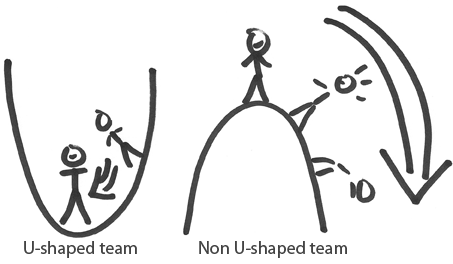I guess you have heard about T-shaped people, that is, people with deep skills within one or a few areas combined with some knowledge in many areas.
Now it’s time to introduce U-shaped teams. That is, teams that are balanced and where teammates are helping each other. It’s a team where you might have a bad day and are allowed to fail without causing consequences. It’s where the teammates help you get back to normal and what’s more make you feel comfortably included in the team. Your team becomes your safety net and it’s the place where you can dare to be vulnerable. U-shaped teams are also good for productivity since safety means productivity. *
The name, U-shaped team, comes from the analogy with a stable system where system comes into balance again after have been moved. The opposite is an unstable system where even a very small change might cause a big difference .
There are plenty of tools that help foster U-shaped teams. Most of them are about knowledge e.g. understanding team dynamics and how people react under stress or during major changes. But also about building trust and the knowledge how to do that. As Patrick Lencioni says: “The key to building trust is not time. It is courage.”**
If you need some tools that will help you create U-shaped teams you’re welcome to the class Make Agile Teams Work.
http://www.crisp.se/kurser/teamutveckling
You can also check in to this blog occasionally or follow me on twitter @tomasbjorkholm to get more tips on how to create U-shaped teams.
/Tomas
PS
Thanks to Per Lundholm for the name, U-shaped teams.
Thanks to Yassal Sundman for fixing the English.
DS
* Alistair Cockburn, Crystal Clear, Personal safety
** Patrick Lencioni, Overcoming the 5 dysfunctions of a team





Nice analogy!
/Mattias
The only problem with U-Shape is the way forward is always upstream, and if you fell down you will hit somebody else 🙂
No really it is Grate Idea. Thanks for a good course.